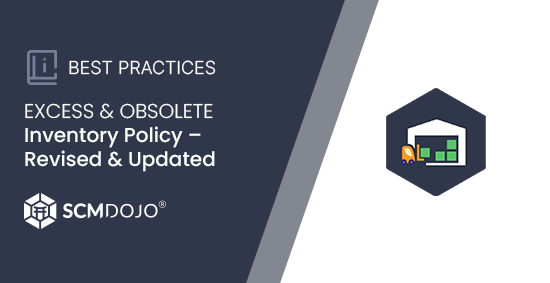Inventory reduction is one of the key goals for most businesses. In this article I have outlined 12 tried and test tips which I have used in my career and find it effective in terms of achieving results.
Get Excess and Obsolete Inventory Policy
Reduce Lead Times
A reduction in lead time will lead to products / materials not being held in stock for a long time. Both a reduction in supplier lead time and manufacturing lead time will contribute to inventory reduction. To reduce lead time the throughput, WIP and cycle time will need to be measured in order to get a realistic estimation of a reduction in lead time. This in turn will reduce the risks related to holding inventory for longer periods of time.

Improve Supplier Rapport
Having an improved relationship with suppliers is highly beneficial not only to the whole supply chain but also with inventory reduction. Having a rapport with the supplier will mean that communication between the parties is effective. The suppliers have the best knowledge of product they produce this can be utilised with a good rapport as this information can be shared. By having a good relationship with the suppliers communicating will be easier.
Smaller Order Sizes
Ordering a smaller volume of inventory, more frequently is beneficial for the company to manage cash flow and also inventory reduction. Depending on the product this will reduce costs associated with keeping a higher volume of inventory. As a result the inventory on hand will be low but the frequency of replenishment will be higher. Having less inventory reduces several risk associated with keeping inventory e.g. issues that can cause a product to depreciate in value.
Reduce Obsolete Stock
By identifying, repurposing or removing obsolete inventory the volume of inventory on hand will decrease. With this both direct and indirect costs of keeping the obsolete inventory will be reduced. This closely links to reduced order sizes as a smaller volume of the inventory will be in stock and as a result fewer inventories will be in stock to become obsolete.
Get Excess and Obsolete Inventory Policy Guide
Pull based Demand / Replenish Based on Demand
A way for inventory reduction is by having a pull based demand system , this means only manufacturing the product once it has been made , this will reduce the risk of obsolete stock as all the materials ordered are being used to make the product. This is different from making a product then selling it therefore as the demand is not certain, this will make forecasting easier. Therefore reducing inventory as it is only ordered when it is needed (this needs a good supplier rapport and short lead time.)
More Accurate Forecasting
Having a standardized reliable way of forecasting demand will mean that excess stock is not order and will reduce the chance of obsolete stock. Utilising all the data available and using up to date technology can help with reductions. Having a more streamlined supply chain with information being passed along and shared can also increase the chance of a better forecast as more information is available.
Reduce SKU or Delayed Differentiation
Reducing the number of SKU’s in a range will mean less of the differentiated products will be produced and allow the benefits of manufacturing homogenous products however this reduction can be difficult but a way of reducing the costs that are associated with differentiation e.g. machine is reconfigured with a new set of algorithms in order to facilitate for the new product , this will save time but another way to diminish the cost would be by delaying the differentiation process to as far down the line as possible as to not cause a disruption to the other products in production.
Pareto ABC
Using Pareto ABC analysis will help determine which inventory is used most often. A is the inventory that is used the most, B- product that ae important but are used less frequently and C these are products that are rarely used. “A” classification products are ones that are used frequently and can therefore be ordered in a small quantity, or be delivered Just in time and will require less safety stock , and C products can be ordered less frequently but with more safety stock kept. In my experience this is the most effective method of inventory reduction and fast!
Better Measuring System
Implementing a system that will recognise when a product needs replenishing and is dynamic can also be useful . Using a system that can change how much to order not only by using how much current stock is on hand but by also a change in trends will help reduce the chance of obsolete stock and excess stock.
More Versatile Components
Using a material or component that is versatile will result in inventory reduction . Ordering a material that can be used in many different products can reduce the inventory on hand .This is because the one material can go into several products , if the material has a high inventory turnover then it can be ordered in a smaller quantity often as above.
Move Inventory up-stream in Supply Chain
Move inventory up stream in supply chain by using Vendor Managed Inventory (VMI) or Consigned Inventory Program. With Strategic suppliers who suppliers high value, volume and frequency items can keep minimum & maximum stocks for you as long as you can cover the liability of that inventory. That means you can simply cut the manufacturing lead time and pull from stock, in turn reduce your safety stocks and/or cycle stocks. Again I have used this tactics quite a lot in my 10 years of supply chain career and this give high gains when it comes to inventory reduction.
Focus on Top 50 High Value Inventory items
During my 10 years in supply chain planning I have found between 20%-25% inventory sits with Top 50 high value inventory items (may vary with different business!). I always ask my material planners to focus on those and “micro manage” them and for rest they can use MRP and Parameter setting. And buy applying one or more of the 11 techniques mentioned above you can reduce significant amount of inventory related to these Top 50 high value inventory items and free up some cash flow
Conclusion
Inventory reduction should not be reactive and by applying one or more of these tips systematically as a part of your standard work a sustainable results can be achieved and lot of cash can be freed up to inventory in other growth initiatives.
Please let me know what you think of these 12 tips and share more ideas if I have missed any!
About the Author- Dr Muddassir Ahmed
Dr MuddassirAhmed is the Founder & CEO of SCMDOJO. He is a global speaker, vlogger and supply chain industry expert with 17 years of experience in the Manufacturing Industry in the UK, Europe, the Middle East and South East Asia in various Supply Chain leadership roles. Dr. Muddassir has received a PhD in Management Science from Lancaster University Management School. Muddassir is a Six Sigma black belt and founded the leading supply chain platform SCMDOJO to enable supply chain professionals and teams to thrive by providing best-in-class knowledge content, tools and access to experts.
You can follow him on LinkedIn, Facebook, Twitter or Instagram







